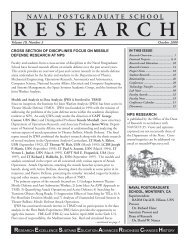Spectral Unmixing Applied to Desert Soils for the - Naval ...
Spectral Unmixing Applied to Desert Soils for the - Naval ...
Spectral Unmixing Applied to Desert Soils for the - Naval ...
Create successful ePaper yourself
Turn your PDF publications into a flip-book with our unique Google optimized e-Paper software.
differences in <strong>the</strong> studies by o<strong>the</strong>r researchers <strong>to</strong> suggest that <strong>the</strong>y <strong>to</strong>o can be correlated<br />
with some sort of functional disruption. Supporting evidence of spectral alteration due <strong>to</strong><br />
impact was determined between ASD collected undisturbed BSC spectra and BSC<br />
spectra associated with trampling. Because <strong>the</strong> endmembers are soils and biological soil<br />
components that are confirmed <strong>to</strong> have undergone impact-related surface disturbances,<br />
<strong>the</strong>n it is reasonable <strong>to</strong> think <strong>the</strong> differences in reflectance are related <strong>to</strong> impact-related<br />
changes in <strong>the</strong> soil.<br />
B. INFEASIBILITY AND MF SCORES<br />
For comparison purposes, both imagery derived and field-measured endmembers<br />
were used in <strong>the</strong> MTMF analysis. The idea behind this was <strong>to</strong> determine if <strong>the</strong> measured<br />
endmembers could achieve similar success results <strong>to</strong> <strong>the</strong> imagery derived ones <strong>for</strong><br />
identifying disturbance-related changes in reflectance. If so, <strong>the</strong>n it could be said that<br />
user supplied endmembers from geologically similar areas would be a successful way of<br />
tracking disturbances in imagery from a geographically different area. Imagery derived<br />
endmembers and user supplied ones were evaluated by continuum removed changes in<br />
band depth, and results indicate that <strong>the</strong>se differences are similar <strong>to</strong> those collected in <strong>the</strong><br />
field. The similarities in calculated band depths associated with absorption features at<br />
500 nm, 1125 nm, and 2200 nm allowed <strong>for</strong> <strong>the</strong> postulation that if <strong>the</strong> results using <strong>the</strong><br />
user supplied endmembers were similar <strong>to</strong> those achieved with <strong>the</strong> imagery derived<br />
endmembers <strong>for</strong> similar types of materials (soils and BSCs), <strong>the</strong>n <strong>the</strong> test could be<br />
considered successful. The MF and Infeasibility scores obtained <strong>for</strong> <strong>the</strong> measured<br />
endmembers were, <strong>for</strong> <strong>the</strong> most part, as successful as <strong>the</strong> imagery derived endmembers.<br />
Because <strong>the</strong> measured endmembers come from areas that are different than <strong>the</strong><br />
location of <strong>the</strong> imagery data, a perfect match was not expected and <strong>the</strong> percentage rate <strong>for</strong><br />
successful detection was set at a lower value than those of <strong>the</strong> imagery derived<br />
endmembers. The idea here was <strong>to</strong> have <strong>the</strong> results yield a low enough infeasibility<br />
number that one could reasonably assume what you were looking at was some mixture of<br />
that endmember and <strong>the</strong> background. The camp road endmembers are a good example of<br />
this at work. While not a perfect match, <strong>the</strong> infeasibility score of between 6 and 10<br />
76
















